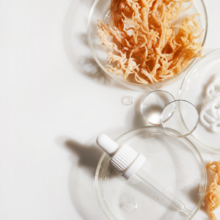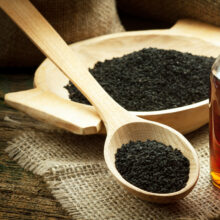Your Guide to Super Seeds
- Published: Friday, April 8th 2016
- in Nutrition
by Millie Ruth Lytle, ND, CNS, MPH, is a naturopathic doctor and works as part of the Live Well / Stay Well Program at Tournesol Wellness
To make any dish healthier, throw some raw or lightly toasted super seeds on it! Sprout them, soak them, grind them and mill them. You can even ferment them.
Amaranth: This super grain produces the Callaloo plant native to the West Indies. Eaten as a gluten-free grain, it is delicious, and an excellent option for gluten-free cereals, breads, and grain dishes. Make these Aztec Energy Bars to enjoy amaranth anytime you need a boost!
Black Seeds: These beautiful seeds resemble a black sesame seed with jagged edges and are known to treat everything but death. A Northern African spice, renowned especially for its healing benefits for the lungs and as a natural anti-viral and anti-bacterial. Black seed strengthens breathing, clears airways, eases gas and bloating, and soothes allergies. The deep black seeds have a pungent taste, like pepper, and are an excellent source of dietary fiber.
Chia Seeds: Yes, like a chia pet. From the Peruvian Andes, it is one of the healthiest foods known to man, it’s what the foot messengers ate, when running from one valley to another. Increases endurance with its high content of omega 3, protein, calcium, and fiber. Can be chewed like gum due to its high mucilage content. It is excellent as a raw breakfast food. Toss a handful into your smoothie, green tea, or lemon water to extract the mucilage properties and aid in healing digestion improve regularity. Try this recipe for Cinnamon-Cashew Butter Smoothie with Chia Seeds.
Cocoa/Cacao: Not a bean but the fully fermented seed of the chocolate plant, is a gargantuan super seed containing antioxidant flavonols that are protective for the heart and brain. Containing circulatory stimulants (but not caffeine) as well as relaxing minerals such as magnesium and zinc that lower blood pressure. This wonder seed can help you remember, focus, and relax all at the same time. It is also contains as phytochemical that mimics the bonding hormone oxytocin, so this is why some people feel in love with chocolate.
Coffee: The coffee bean is actually a seed. While too much coffee can cause the jitters, anxiety, and insomnia, a cup or two per day is great for circulation, focus, concentration, energy, and diuretic action. For those who don’t consume it regularly, a little shot can be great for treating a migraine headache.
Coriander Seeds: Aromatic and great for balancing bad bacteria in the mouth, these mineral rich seeds are also a good source of vitamin C and vitamin A. Like its cousins, dill, fennel, and caraway, coriander helps ease gas and bloating as well. Coriander seeds can be grown into cilantro, one of the best food-based heavy metal detoxifiers. Eat with canned tuna to block mercury absorption.
Flax Seeds: Source of fiber, protein, omega-3, mucilage, phytoestrogens, and anti-cancer lignans. Grind the flax seeds to get the most out of them. Take one tablespoon with yogurt and berries before going to bed. I have moved away from recommending flax oil because it’s so unstable. If you consume it make sure it’s high lignin and raw.
Hemp Seeds: The butter cream of seeds, hemp is the non-hallucinogenic form of marijuana, the male cannabis plant. It has absolutely no drug-like activity, but it is a natural resource beyond compare. The gentle seeds are filled with omega-3 fatty acids, like vegan fish oils. They have protein, fiber, and are non-allergenic, unlike sesame and sunflower seeds. Toss them in salads and other vegetable dishes to increase protein content. The plant can also provide sustainability in replacing trees to make paper and wearable fabrics. The first pair of Levi’s Jeans were made from this hearty plant.
Mustard Seeds: The source of the condiment and mustard oil, the seeds contain a rich amount of selenium as well as a spectrum of omega 3 fats, manganese, copper, magnesium, and calcium. Their aromatic flavor is excellent for fighting colds and congestion, warming the body, improve circulation, and can be rubbed on the chest in a decongesting poultice.
Pomegranate Seeds: Sure the red pulp is wonderful for your arteries, heart, and blood circulation. But to balance the sugar from the fruit itself, you need to eat the white fibrous seeds for the fiber and potassium. An absolute super food, the entire pomegranate seed will help balance your blood sugar, add it as a flavor for chia pudding. Toss them with olive oil, mint leaves, mustard, and cumin seeds for a terrific and unusual salad.
Pumpkin Seeds: Pepitas are a terrific source of omega 3 fatty acids, when eaten raw. Pumpkin seeds are rich in zinc, good for a man’s prostate and helping to lower excess estrogen levels. Like most seeds, pumpkin seeds are a healthy combo of good fats, protein, and fiber, as well as being an intestinal cleanse for parasites and yeast overgrowth.
Quinoa: While quinoa is higher in fiber and protein than rice or oats and is gluten-free, the downside is that in becoming a basic for North American health purveyors, the price has become so inflated that Peruvians can no longer afford to eat their staple. Incorporating these super seeds into your diet, especially after a workout rebuilds muscles, stamina, and energy as well as cellular repair.
Salmon Roe: Roe or caviar is another animal seed. Did you know one ounce provides a whopping 8 grams of protein, 55 percent of the recommended daily B12 intake, and a combination of polyunsaturated and monounsaturated fats, it truly is nature’s fish oil.
Tamarind Seeds: Usually we think of the bitter-sweet fruit but the seed of the tamarind pod is medicinal to the hilt. Roast it first for a great snack. It contains phosphorus, magnesium, vitamin C, potassium, calcium, and amino acids. Tamarind seeds are great for diarrhea, strengthening teeth and bones, and healing skin. Consume half a teaspoon of roasted tamarind seed powder twice a day with water for natural source of hyaluronic acid/collagen for lubricating joints.




